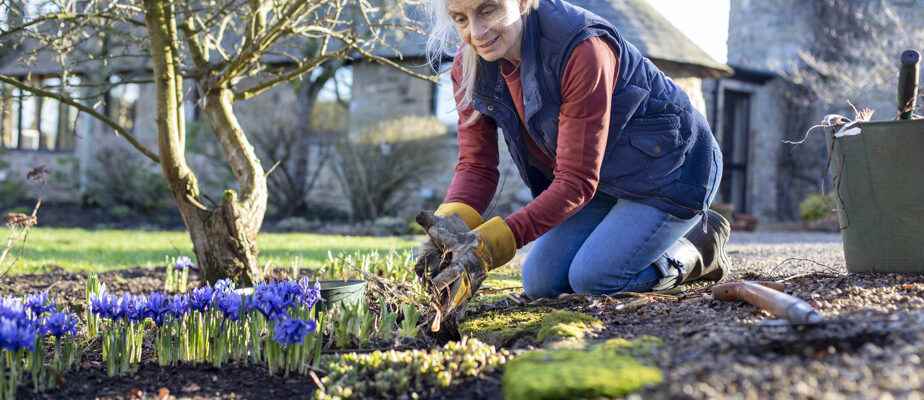To bring spring color to your lawn for years to come, plant bulbs before the cold fall: little wonders will appear here and there on your still yellow lawn, sometimes as early as the end of March. Here are some tips for sprucing up your yard for the first days of spring.
Posted at 12:00 p.m.
Several species of spring-flowering bulbous plants are suitable for planting in lawns. They are small, relatively inexpensive and flower early. In addition to offering a wide range of colors, these little gems are hardy, do not require maintenance and bloom for years.
Erenthus and certain crocuses are among the earliest in our climates. Besides, Eranthis hyemalis means spring flower in Greek. This tiny beauty of barely 7 or 8 cm is distinguished by its bright yellow flower surmounting a cute green collar.

PHOTO ARCHIVES PRESS
Crocuses come in a variety of colors and bloom in March or April.
With crocuses, attention should be paid to the species indicated on the package. Avoid the many varieties of vernus crocuses, popular, which are often much bigger, but later. We will rather focus on crocus chrysanthus, ancyrensis and tommasinianus – don’t be put off by these scientific names. All have various colors depending on the variety, flower in March or April, reach about 10 cm and are easy to find in garden centres.
Particularly suitable for lawns, squills produce pretty dark blue bells (there is a white variety) and will multiply over the years if the growing conditions are adequate. Also all dressed in blue, but with a white heart, chionodoxas are unknown. They offer us two or three flowers per floral stem, and their height does not exceed 15 cm. As for snowdrops or galanthus, their brilliant white flowers usually emerge in mid-April and are scorned by squirrels.
-

PHOTO ARCHIVES PRESS
Very dark blue, the delicate squills usually grow in size over the years.
-

PHOTO ARCHIVES PRESS
Always spectacular, snowdrops grow very well in the lawn.
-

PHOTO ARCHIVES PRESS
Erthes are among the earliest bulbous plants in spring.
-

PHOTO MENEERKE BLOEM, WIKIMEDIA COMMONS
Little known, but very pretty, chionodoxas are perfect for flowering a lawn as soon as the snow melts.
1/4
A bit of a hammer method
Mid-September is the perfect time to plant small bulbs in the lawn. They will still be plump. Later in the season, they are sometimes dehydrated on the stalls and recovery is less good. Early planting also allows the bulb to produce roots quickly. Also, make sure that the place chosen in the lawn is not in a depression where water can accumulate during the winter. In this case, it will be complete failure by asphyxiation.
For a beautiful effect, it is absolutely necessary to group several bulbs on each planting site. For example, in a circle of 30 cm in diameter, 25 bulbs and more can be arranged.
The planting depth should reach three or four times the diameter of the bulb. If the number to be planted is large, it is preferable to remove a patch of grass, put in the ground, put the grass back in place and water everything.
You can also use a hammer with a fairly long head (5 or 6 cm); a method that I have used successfully for years. We give good blows on the ground close to each other, then we insert the small bulb in the hole, which we cover with compost. You must then gently pass the leaf rake and your planting will go almost unnoticed. Again, water well.

PHOTO BERNARD BRAULT, PRESS ARCHIVES
Planting bulbs with the help of a hammer seems rather unusual, but the method gives good results.
Tanning squirrels and late mower
And the squirrels? The problem is often unavoidable. Granulated chicken manure is sometimes a good repellent, but know that nothing will stop a hungry squirrel. Believe me, over the years I’ve tried everything.

PHOTO MARTIN CHAMBERLAND, ARCHIVES LA PRESSE
Remember that squirrels will stop at nothing to destroy your precious plants.
All that’s left is the wire mesh. Inexpensive, it can be placed on the plantation, but firmly fixed. In the spring, as soon as your plants show the tip of the nose, it will be enough to remove it.
Be careful, remember that once flowering is over, your plants will need all the energy produced by their leaves to bloom again the following spring. It will therefore be necessary to delay cutting the grass at least towards mid-May and cut high, to 8 cm.

PHOTO GETTY IMAGES
The tiny reticulated irises are real gems. But you still have to give them time to stock up to allow them to bloom again. Lawn mowing should therefore be delayed until at least mid-May.
At the foot of my tree
Normally, grass should never touch the trunk of a tree, if only to avoid injury from the lawnmower or edger. This free space is also ideal for planting small bulbs.

PHOTO ARCHIVES PRESS
White or blue, Greek anemones are perfect for flowering at the base of trees. They are very hardy and flowering is long.
For years, my anemones from Greece (Anemone blanda) blue or white grow under a spruce and at the foot of a beech. In addition to the species mentioned, puschkinia, muscari, Spanish hyacinth, ixiolorion, vernus crocuses and the pretty but tiny Iris reticulata will agree. Another avenue for your spring to be more beautiful than ever.

